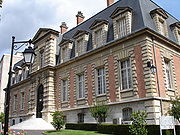
Musée Pasteur
Encyclopedia

Louis Pasteur
Louis Pasteur was a French chemist and microbiologist born in Dole. He is remembered for his remarkable breakthroughs in the causes and preventions of diseases. His discoveries reduced mortality from puerperal fever, and he created the first vaccine for rabies and anthrax. His experiments...
. It is located within the Institut Pasteur at 25 Rue du Docteur Roux, Paris
Paris
Paris is the capital and largest city in France, situated on the river Seine, in northern France, at the heart of the Île-de-France region...
, France
France
The French Republic , The French Republic , The French Republic , (commonly known as France , is a unitary semi-presidential republic in Western Europe with several overseas territories and islands located on other continents and in the Indian, Pacific, and Atlantic oceans. Metropolitan France...
, in the XVe arrondissement
XVe arrondissement
The 15th arrondissement of Paris is one of the 20 arrondissements of the capital city of France.Situated on the Rive Gauche of the River Seine and sharing the Montparnasse district with the 6th and 14th arrondissements, it is the city's most populous arrondissement...
, and open daily in the warmer months; an admission fee is charged.
The museum was established in 1935 in honor of Louis Pasteur
Louis Pasteur
Louis Pasteur was a French chemist and microbiologist born in Dole. He is remembered for his remarkable breakthroughs in the causes and preventions of diseases. His discoveries reduced mortality from puerperal fever, and he created the first vaccine for rabies and anthrax. His experiments...
(1822-1895), and preserves his memory in the apartment where he spent the last seven years of his life, as well as an impressive room where some 1,000 scientific instruments are exhibited, and the Neo-Byzantine chapel in which he is buried.

